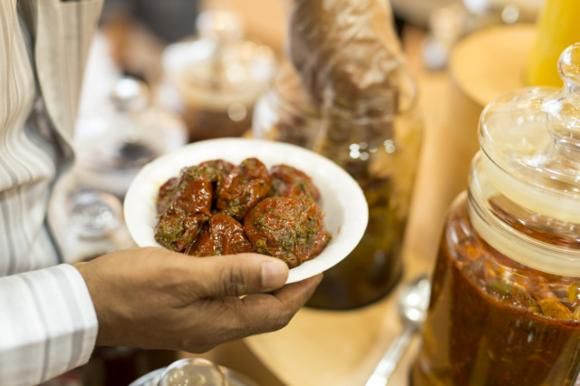
A gold-domed jar squats on my white kitchen counter table. This gift from an Emirati mother is full of soft mango chunks and chewy lemon wedges, suspended in an oily syrup fragrant with mustard seeds, chili flakes, curry leaves and sweetened vinegar. When I find myself starved of both food and time to cook during the week, I’ll unscrew the lid and go to town with whatever I can get my hands on: roti, bread, rice, fingers.
Read: Loomi: Dried limes that should be tossed in, not out
Achaar, the Indian term for pickle, is one of the oldest forms of preserving fruits and vegetables in salt, sometimes oil or vinegar, and spices. The prolonged salty bath extracts the moisture out of the fruit or vegetable, deepening its flavour so that the slightest smear on the tip of your tongue is instant botox for a bland meal. My family usually stocks a range of achaars made by our grandmother or by someone else’s grandmother. If a store-bought version makes it to the table, then we must consume it whilst reminiscing about our grandmother’s original version and glorify her achaar in absentia.
Read: Why you need to start eating in Mamzar
Food historians are conflicted about the origins of the word ‘achaar’ but at least they all agree that it is not originally Indian. Some say the word is derived from Persian or Arabic, which is ironic since the Iraqis and Iranians refer to it as ‘torshi,’ while the Levant calls it ‘mukhalal.’ The Gulf Arabs reverse the attribution and claim it is Indian. Confusingly, ‘achaara’ is also the Tagalog word for pickled papaya which is paired with fatty meats. Achaara might have fermented from the word ‘aji picante’ for chilli pepper as used by the Spanish colonialists in the Philippines, who were in turn influenced by Columbus’ discoveries in the Americas. Often a key ingredient in achaar, chilli peppers are indigenous to the Americas (and not India) where an 18th century German botanist noted that they were called ‘axi’ or ‘achi.’
The science of pickling is even more fascinatingly complex than achaar etymology. To grossly oversimplify, there are two kinds of microbes in fermented life: good microbes and bad microbes. The good guys grow in oxygen-starved environments like airtight jars or submerged in liquid, and they consume the sugars in the fruit or vegetable being preserved. They engineer lactic acid and other acidic compounds that strike down the evil microbes plotting to rot our precious lime peels, mango flesh or whatever else may live in our pickling jars.
But not all good microbes are born equal. Temperature and salt concentration are the parents that determine the nature of the microbial children being born. My Indian mother-in-law insists that achaar needs to be left out in the sun for it to soften in texture and ripen in flavour. Huma Al Hashemi, who gifted me my soulmate jar of mango pickle, describes how the older generation of Emiratis used to store their onion achaar in jars under the sun ‘to cook’. This time-tested technique produces a set of microbes that unleash a stronger, more pungent flavour than microbes born under cooler temperatures.
Many pickling recipes such as the Emirati ones kick start the process with vinegar and don’t wait around for microbes to generate acids. The resulting milder flavour pairs well with fragrant Emirati machboos and juicy kababs.
Science aside, Huma vouched for ‘wisdom, experience and love’ as the three core ingredients for achaar. That is why granny’s version is the best.
My favourite achaar shop in Dubai is as close to a grandmother’s pickle pantry as one can get. Big Bombay Bazaar stocks tall jars of achaar that release a funky mix of aromas all through the shop – mango, mustard, chilli, lemon, sesame, garlic and more. The owner, Mehul Gandhi, imports his speciality pickles from all over India, including ‘gongura’ pickle made out of sour hibiscus leaves from my hometown, Hyderabad. He stocks everything, from mild sweet lime and gooseberry pickles, to achaar that ‘will make you dance’. The stuffed red chilli and my father’s preferred green chilli pickle in mustard oil will spark more than a shimmy.
Huma mentions the Bahrainis as the most prolific picklers in the south Gulf; be it okra or chickpeas, everything is a candidate for the achaar jar. She assigns me homework to visit Bawabat Al Bahrain, a shop in Sharjah that imports their achaars from Bahrain.
For those too lazy to venture out for a pickle purchase, there is always Instagram. Those in-the-know get achaar delivered home from an Emirati lady who runs a pickling operation using ingredients from her farm in Ras Al Khaimah. Umm Abdullah is something of a social media sensation with over 60,000 followers who swoon over her mango (‘hamba’), lime (‘loomi’), red cabbage, onion and mixed vegetable pickles. She delivers right to your doorstep as long as you invest in about two hundred dirhams worth of achaar, which is more than a year’s worth of what I’d need at home.
Thankfully, pickle doesn’t go bad.












